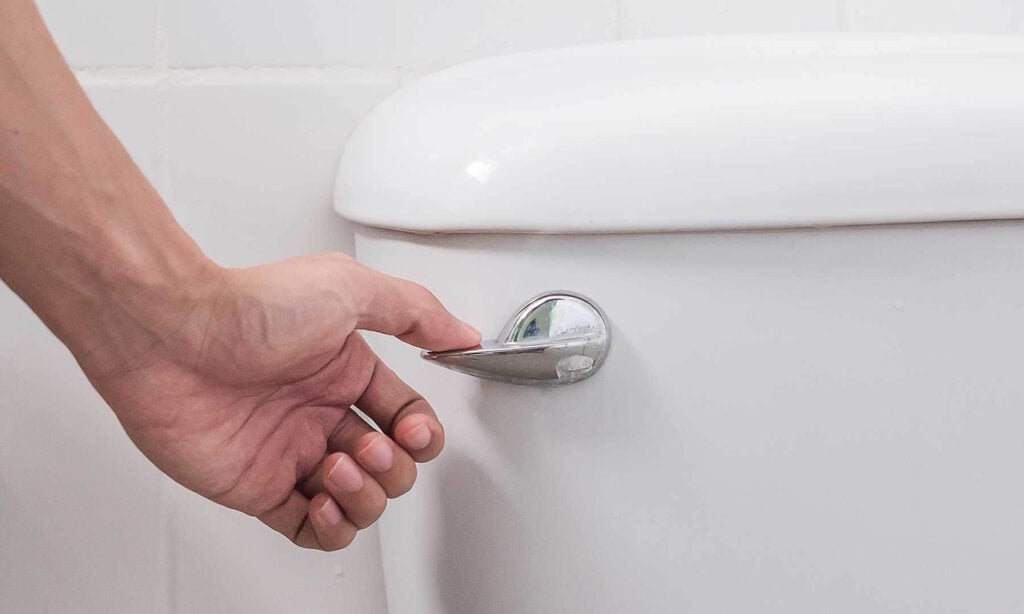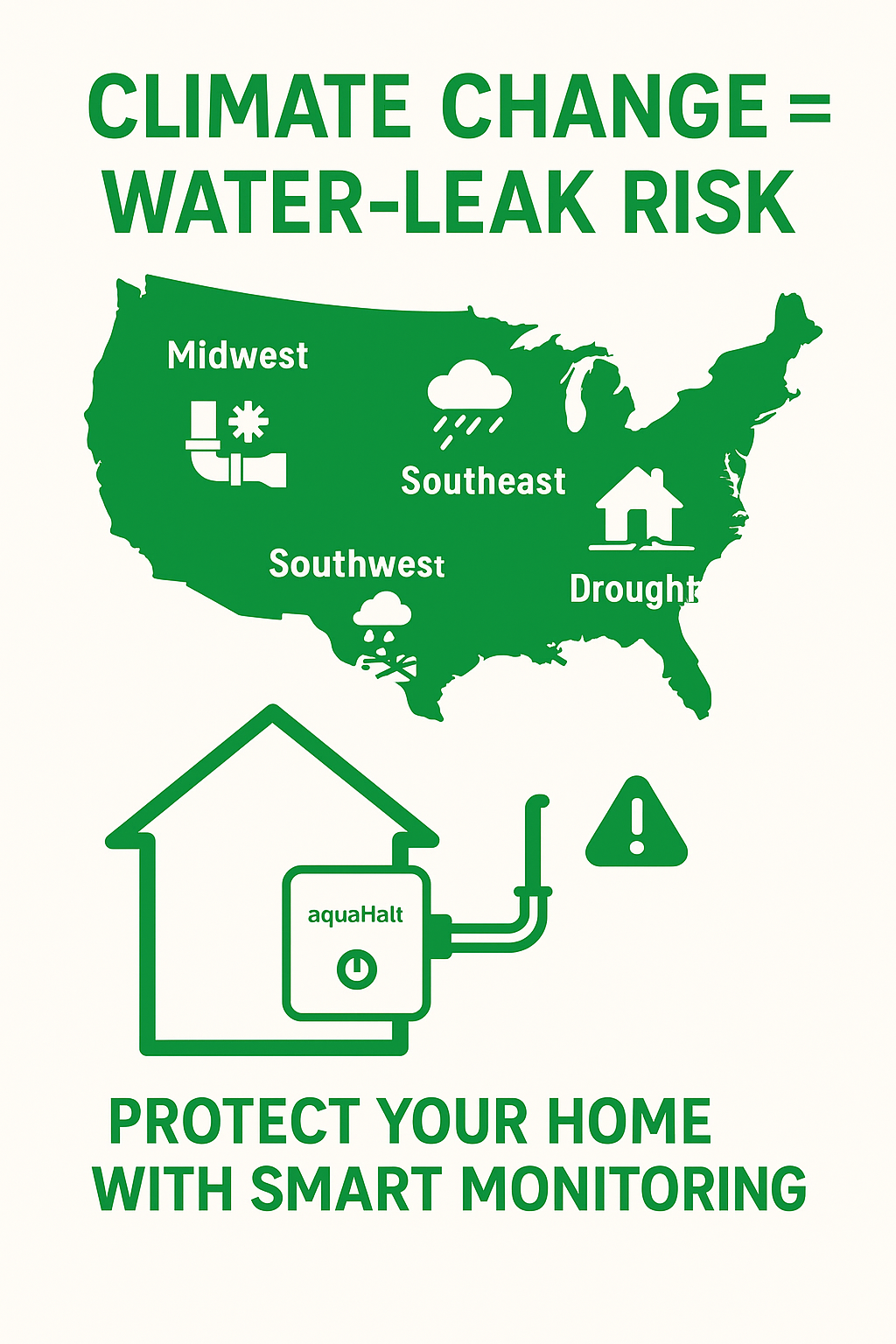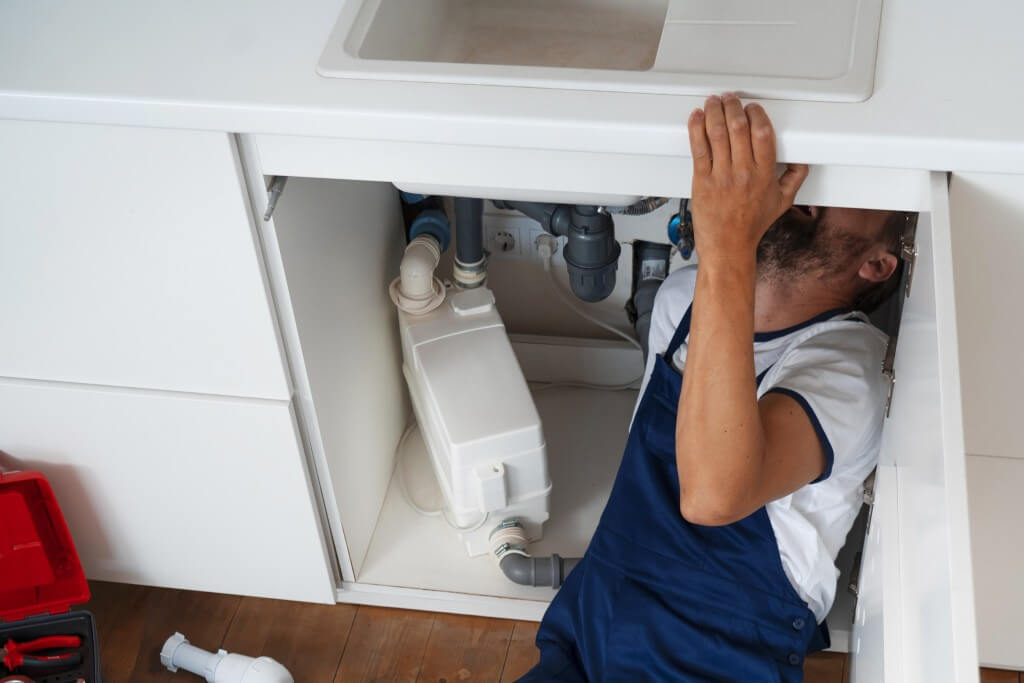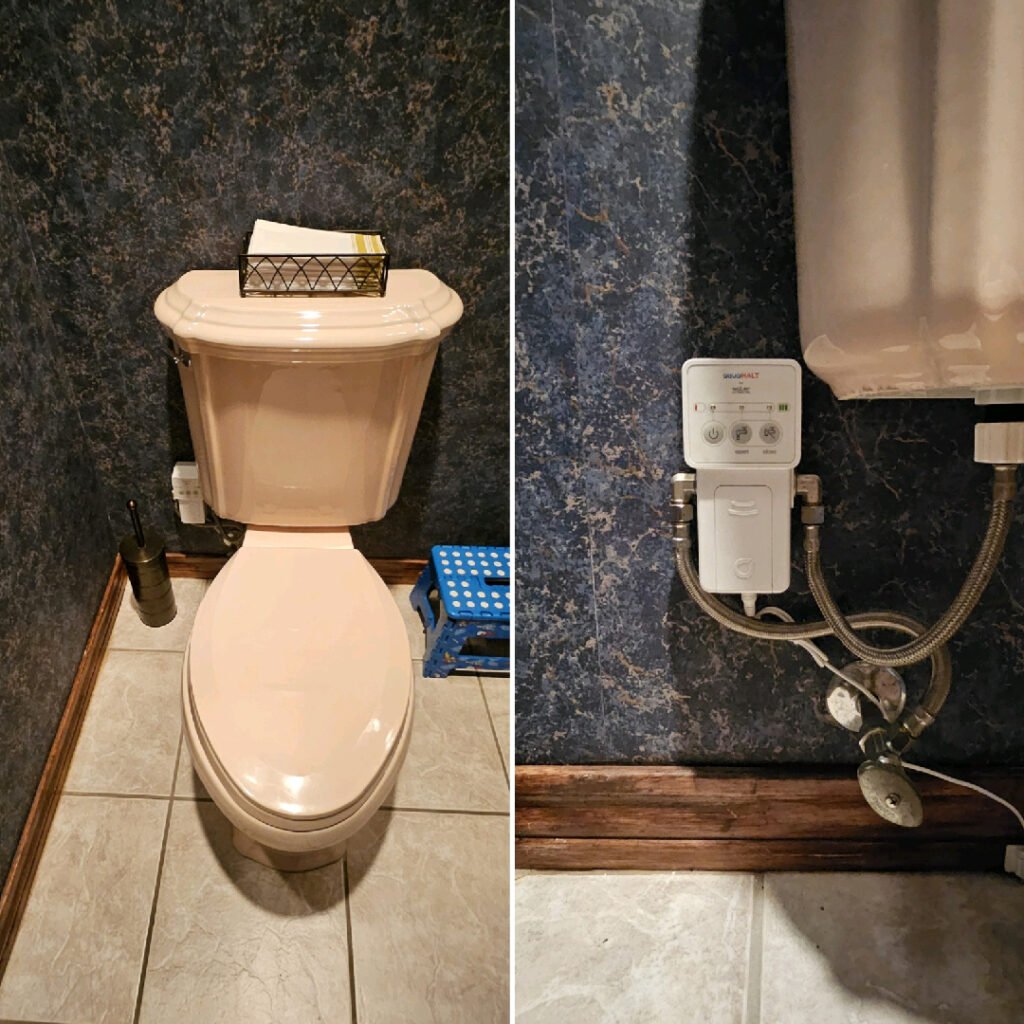
If you have heard a moaning, groaning, or humming noise when you flush your toilet, you are probably feeling annoyed and frustrated that you have been unable to locate the issue and fix the problem. In fact, it may take you a while to determine where the noise is coming from. You may think that it is coming from your pipes or a gremlin in the basement, but rest assured, the culprit is most likely your toilet.
This annoying noise coming from within your toilet tank is an indication that something is wrong. Consider it a warning that a more serious problem is lurking in your future if it is not taken care of immediately. Leaks, excessive water loss, damage to your floors and walls, and other major expensive problems may lie ahead.
No one wants to be faced with a leaking toilet. aquaHALT offers an easy-to-install system that not only detects water leaks but also shuts off the water source and sends an alert directly to you. Save yourself money, time, and headaches by installing an affordable solution with aquaHALT.
There can be several sources of noise from your humming toilet, but perhaps the most common is inconsistent water pressure. Pressure exerted against the diaphragm in the fill valve can cause the issue. This can be adjusted through a pressure reducer valve located near the meter. Be sure to check the diaphragm for wear or weakness as well.
If the humming is more like a loud groan, check that all the washers are tight and the ballcock assembly is working as it should. If you think this is the problem, try opening the tank, lifting up on the float, and flushing. If the groan goes away, you may have found your problem: a loose washer. Locate the three screws at the top of the fill valve, Turn off the water, and flush to empty out the tank. By unscrewing the screws, you can remove the ball, armature, and the top of the flush valve. Take the washer out of the bottom of the valve and replace it with a new one.
If this does not solve your humming problem, you may need to replace the fill valve. Once you have replaced the fill valve, adjust the water level within an inch of the overflow tube. If you are still hearing the noise when you flush, it could be a vibration in your water supply lines.
If your water supply lines are vibrating, you will hear a noise as the toilet refills. This could lead to serious problems since the vibrations could result in splits in your lines and excessive water leaks.
Leaking toilets are the cause of expensive home repairs, wasted water, and excessive water bills. The damage can destroy floors and subfloors, walls and trim, and even other fixtures. aquaHALT can be an economical solution to water leak detection. This system is easy to install without the use of a plumber. At the first indication of a leak, the battery-operated system can shut off the water supply and signal an automatic alert.
If your toilet is humming an inharmonious tune, install aquaHALT today. Stop water leaks before they start by simplifying your toilet maintenance with aquaHALT by water AUTOMATION. Contact us for more information or to place an order!

What’s happening: Climate change is increasing water-leak risk in US homes by altering weather patterns—more freeze-thaw cycles, heavier rainstorms, and shifting soil conditions are straining home plumbing systems like never before.
As climate shifts intensify across the United States, the risks of water damage in homes are rising sharply. Homeowners are seeing more frequent and severe plumbing failures tied to unpredictable weather — and most don’t realize that these leaks are directly connected to climate-driven factors.
Increased freeze-thaw cycles, heavier rainfall, and even alternating drought and flooding events are putting new stress on residential plumbing systems. These subtle yet powerful changes can silently destroy property foundations, flood basements, and cause thousands in damage before the issue is even detected.
In the Midwest, climate change has increased temperature volatility. According to NOAA, freeze-thaw frequency has risen by 12% over the past decade. This means pipes are freezing and thawing more often — expanding, contracting, and eventually bursting.
Once a pipe bursts inside a wall or under a crawl space, homeowners may not notice until significant water loss has already occurred. That’s where aquaHalt’s automatic shut-off system comes in: it detects abnormal water flow and immediately cuts off supply before catastrophic damage occurs.
Quick Tip: Insulate pipes in unheated basements, attics, and exterior walls before winter. Even a simple insulation sleeve can reduce the chance of freezing by 85%.
In the Southeast, the challenge isn’t freezing — it’s flooding. Climate change has brought heavier, more concentrated storms. FEMA data shows that the region’s annual stormwater incidents have risen by nearly 20% since 2015.
This deluge increases groundwater pressure around homes, leading to foundation cracks and sump pump overloads. Once water infiltrates the foundation, it can weaken concrete and trigger long-term mold and structural issues.
Installing smart leak sensors near sump pumps and basement perimeters gives early warnings before leaks become full-blown floods. Pairing these sensors with aquaHalt’s smart shutoff adds an automated layer of protection during storm surges.
In the Southwest, the water problem flips. Prolonged drought causes the soil to dry out and contract — then flash floods suddenly soak and expand it, putting extreme stress on underground plumbing and slab foundations.
These fluctuations can fracture older pipes or loosen fittings beneath concrete. It’s a silent destroyer: leaks may continue for weeks before showing signs like rising water bills or damp patches on flooring. Monitoring systems such as aquaHalt can catch micro-leaks early by detecting abnormal flow rates and sending instant alerts to homeowners.
According to the EPA (2023), nearly 80% of household water leaks occur in hidden or underground lines. Unlike visible drips, these leaks go unnoticed — causing:
Foundation erosion
Mold growth
Rising humidity
Insurance premium hikes
Once water seeps into walls or slabs, repair costs skyrocket. A hidden pipe leak can cause $10,000+ in restoration expenses, while a smart monitoring system costs a fraction of that.
Region | Preventive Steps |
|---|---|
Midwest | Insulate pipes, seal crawl spaces, drain outdoor lines before winter. |
Southeast | Inspect gutters, test sump pumps, add basement humidity sensors. |
Southwest | Check slab plumbing annually, install leak sensors near appliances and radiant systems. |
These steps, combined with smart monitoring, can cut water damage risks by up to 60%.
The Insurance Information Institute (2024) reports that the average US water damage claim is $11,605. Compare that with the $250–$400 investment in a home leak-detection setup, and the math is simple — prevention pays for itself the first time it stops a leak.
Add the peace of mind from 24/7 protection, and the value extends beyond dollars: it’s about safeguarding family, property, and future resale value.
Audit all vulnerable water lines — especially older or outdoor systems.
Install smart sensors in high-risk areas like basements, slab floors, and laundry rooms.
Schedule seasonal inspections (spring and fall) to test for freeze or flood readiness.
Learn more about aquaHalt and how it can automate your home’s water protection system.
Climate change isn’t slowing down — and neither should your home’s protection. From Midwest cold snaps to Southeast storms, the key to resilience lies in data, detection, and decisive action.
By integrating aquaHalt into your home’s plumbing ecosystem, you’re not just installing a device — you’re building an intelligent defense system against tomorrow’s weather extremes.
Hidden plumbing leaks are one of the costliest threats to American homes. According to the Insurance Information Institute, water damage accounts for nearly 24% of all home insurance claims in the US, with average repair costs ranging from $3,000–$10,000. The culprit? Not always burst pipes — often, it’s leaks buried in slabs, floors, or behind walls that go unnoticed for months.
Below are the 10 most overlooked plumbing lines that can silently destroy property — and how smart detection tools like aquaHALT can help you stay ahead.
Why they leak: Corrosion or pressure buildup over time.
Risk: Hard to spot since pipes are embedded under tile or concrete.
Monitoring Tip: Use moisture sensors along baseboards near heated areas; install shut-off devices that respond instantly when leaks start.
Why they leak: Movement in foundations or aging copper lines.
Monitoring Tip: Look for warm spots on the floor or unexplained spikes in water bills. Pair these with an aquaHALT shut-off system to stop water flow automatically when abnormal patterns occur.
Often small and plastic, these lines crack or disconnect easily. A slow drip can rot cabinetry or floors within weeks.
Prevention: Add a leak detector like aquaHALT ICE, designed for ice-maker fittings under sinks or behind fridges.
These operate under constant pressure and can burst.
Tip: Replace every 5 years and use sensors near connections.
Visit aquaHALT H/C – Sink Protection to find the right device for your need.
When partially blocked or frozen, they can backflow and flood basements.
Monitor: Regularly inspect outdoor discharge points and use moisture sensors near the sump area.
Common in humid regions like the Southeast US.
Why it matters: Clogged drain pans overflow, damaging drywall.
Prevention: Annual maintenance plus under-unit leak detection.
Cracks from winter freezes are common.
Regional Tip: In colder states (e.g., Minnesota, Michigan), disconnect hoses before winter and insulate bibs.
Small, flexible tubes can leak unnoticed in basements or utility rooms.
Tip: Place a sensor under each connection and test monthly.
Leaks here travel behind walls.
Detection: Install small floor-level sensors in adjacent rooms, especially on upper floors.
A notorious culprit for overnight flooding.
Solution: The aquaHALT 2X or Flip models automatically detect leaks and shut off the water before overflow occurs.
A family in Dallas, TX discovered a slab leak only after noticing a $200 jump in their water bill. Repairs required concrete cutting and floor replacement — costing over $7,500. A $165 or less shut-off device could have prevented 95% of that damage.
Item | Average Cost | Preventable With |
|---|---|---|
Slab Leak Repair | $3,000–$7,500 | Flow-based shut-off valve |
Radiant Floor Repair | $1,200–$5,000 | Sensor + shut-off combo |
Ice Maker Leak Damage | $2,000–$4,500 |
Identify all water lines running under floors or behind walls.
Install smart leak sensors at low points (e.g., baseboards, near valves).
Test your system monthly.
Pair with aquaHALT shut-off valves for automatic protection.
Review data via app or indicator lights to ensure coverage.
Hidden leaks can strike any home — but you can prevent costly disasters before they start.
Equip your home with aquaHALT protection today and gain peace of mind knowing your plumbing system is monitored 24/7.

Hidden leaks are like the ninjas of home damage – silent, sneaky, and devastating. While you’re living your best life, they’re slowly waging war on your walls, floors, and savings.
You won’t hear them. You won’t see them. But one day, you’ll smell them. That’s usually the mold, announcing its victory.
It’s not dramatic to say that hidden leaks are one of the most expensive home problems that no one talks about – until it’s too late.
Water is a professional escape artist. Once it finds a weak point – a loose connection, a cracked seal, or a tiny pinhole in a pipe – it escapes quietly into places you can’t reach.
It travels along beams and insulation, soaking everything along the way. And because it’s hidden, you don’t notice it until:
By then, the damage isn’t just cosmetic – it’s structural.
If hidden leaks are the ninjas, mold is their evil sidekick. Once moisture lingers for more than 24–48 hours, mold spores throw a party.
They spread fast, latch onto porous materials, and start producing that lovely “damp basement” smell that every homeowner dreads.
And while it might start small, mold cleanup is no joke. Depending on how far it’s spread, mold remediation can cost anywhere from $1,200 to over $6,000 – not counting the damage it’s caused along the way.
Some homeowners spend months dealing with cleanup crews, insurance adjusters, and the emotional trauma of tossing out their favorite furniture. All because of one tiny leak.
Let’s put this into perspective:
Problem | Average Cost | Avoidable With Early Detection? |
|---|---|---|
Replacing water-damaged flooring | $2,500–$5,000 | ✅ Yes |
Mold remediation | $1,200–$6,000 | ✅ Yes |
Structural repair from rot | $5,000+ | ✅ Yes |
Water damage insurance claim | $11,000 average | ✅ Yes |
So when you compare that to the $150 price tag of aquaHALT, the math starts to make sense – prevention is the ultimate money-saver.
Some of the most common culprits for hidden leaks include:
Water doesn’t need an open tap to do damage – a single, tiny crack under pressure can release liters a day.
And the scary part? You won’t notice a thing until you step onto a warped floorboard or spot that telltale stain spreading across the ceiling.
Early detection isn’t just about saving money – it’s about keeping your home livable and your stress levels low.
When a hidden leak goes undetected, you’re in for:
Catching the leak early means you avoid all that. No stress, no surprises, no soggy carpets.
Now, imagine if your home had a tiny, tireless guardian that could hear trouble before it struck. That’s aquaHALT, created by waterAUTOMATION.
For just $150, you get a battery-powered leak detection device that works 24/7 – even during power cuts. It runs on 2×AA batteries, installs in seconds, and doesn’t need Wi-Fi, an app, or your Saturday afternoon.
Just place it near problem areas – under sinks, behind appliances, near your water heater – and it immediately starts listening for leaks.
When water appears where it shouldn’t, aquaHALT sounds the alarm before you’re knee-deep in trouble.
We live in an age where everything’s “smart.” But do you really need a leak detector that connects to the cloud, syncs with your toaster, and asks for monthly updates?
No. You just need something that works – reliably, quietly, and immediately.
That’s why aquaHALT’s simplicity is its superpower. It doesn’t rely on Wi-Fi or fancy integrations. It just protects your home, day and night, for pennies a day.
It’s like having a loyal guard dog for your plumbing system – minus the barking.
You don’t need to wait for mold, warped floors, or a swollen water bill to take action.
Preventing water damage isn’t rocket science – it’s awareness, preparation, and a little help from the right device.
So, before water sneaks up on you, sneak up on it.
Install aquaHALT once, sleep better forever.

Let’s be honest – home disasters don’t usually knock first. They kick the door down. One minute you’re watching TV, the next your laundry room looks like a kiddie pool.
Water leaks are sneaky like that. They strike when you’re least prepared – on holidays, overnight, or that one weekend you actually decided to relax.
But what if one small, $150 device could stop all of that before it even began?
Meet aquaHALT, the tiny hero by waterAUTOMATION that quietly stands guard while you’re out living your life.
In a world where everything needs charging, updating, and syncing, aquaHALT is refreshingly simple. It doesn’t need Wi-Fi, a smartphone app, or a 43-step setup process.
It runs on two AA batteries – that’s it. Pop them in, place the device where water might cause trouble (under your sink, behind your washing machine, near the water heater), and you’re done.
No monthly subscriptions. No pairing codes. No software updates at 2 a.m. Just old-fashioned reliability in a smart little package.
Sure, “smart home” leak detectors sound cool – until your Wi-Fi goes down, your app glitches, or your phone dies.
aquaHALT doesn’t care about Wi-Fi signals or firmware updates. It’s too busy doing its job:
listening 24/7 for the faintest sign of water where it doesn’t belong.
And when it finds one? It lets you know – immediately. Loudly.
Because the only thing worse than a leak is not knowing you have one.
At first glance, aquaHALT doesn’t look like much – just a compact device powered by two humble batteries. But under the hood, it’s a powerhouse of prevention.
Its high-sensitivity water sensors can detect even small amounts of moisture before they turn into major problems.
That means no more waking up to soggy carpets, dripping ceilings, or that dreaded “splash” sound when you step into the laundry room.
In other words, aquaHALT doesn’t wait for disaster – it prevents it.
One of the biggest myths about water damage is that it only happens in older homes.
Wrong.
Even brand-new builds can have leaks – from shifting foundations, loose fittings, or appliances that weren’t installed perfectly. Water doesn’t discriminate.
So whether your house is 30 days old or 30 years old, a leak detector is a must-have.
Think of aquaHALT as an equal-opportunity protector.
Leaks don’t punch time cards. They don’t take weekends off. That’s why aquaHALT never clocks out.
While you’re asleep, at work, or away for the holidays, it’s still watching, still listening, and still ready to sound the alarm if water shows up where it shouldn’t.
It’s like having a personal security guard for your plumbing system – minus the attitude and the coffee breaks.
Installing aquaHALT takes less time than making a cup of coffee:
That’s it. No wiring. No Bluetooth pairing. No instruction manual thicker than a novel.
Just quiet protection you don’t have to think about until it saves you.
It’s the kind of device you forget exists – until the day it saves you a fortune.
Our homes are getting smarter – but sometimes, simple tech wins the day.
aquaHALT is proof that you don’t need Wi-Fi, cloud syncing, or subscription plans to protect what matters.
Just a small device, a little foresight, and two AA batteries.
Leaks don’t care about your schedule, your new floor, or your peace of mind. But aquaHALT does.
For $150, it gives you round-the-clock protection, zero setup headaches, and the priceless satisfaction of outsmarting water itself.
Because the best home upgrades don’t just make life easier – they make it drier.